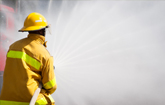January is National Radon Action Month; the American Lung Association urges every household to test for radon gas
CHICAGO, Jan. 6, 2025 /PRNewswire/ -- Radon, a colorless, odorless and tasteless gas is responsible for around 21,000 deaths each year and continues to be the second leading cause of lung cancer in the United States. During January's National Radon Action Month, the American Lung Association is urging everyone to help save lives by testing their home for radon and mitigating if high levels are detected.
Radon is a naturally occurring radioactive gas emitted from the ground, and can be found at dangerous levels inside homes, schools and other buildings in every U.S. state. Radon gas can be inhaled into the lungs, attacking cells with dangerous, cancer-causing radiation.
For National Radon Action Month, the Lung Association offers facts and tips to protect families from radon exposure:
- Testing is the first step in reducing the risk of radon-induced lung cancer. Elevated levels of radon are found in homes in every state, and in some states, radon levels are elevated in as many as 1 in 3 homes. The only way to detect radon in a home is to test the air. Do-it-yourself test kits are simple to use and inexpensive. As a part of a partnership with Protect Environmental, the Lung Association is offering free radon test kits in select markets nationwide. Learn more and request a test kit here. Radon testing is recommended every two years.
- Always test when buying a home. Testing for radon is always recommended after a person purchases a home. Resources are available for new homeowners here, and are available for real estate professionals here.
- Use test results to mitigate the risk. Radon is measured in picocuries per liter (pCi/L). The Environmental Protection Agency recommends taking action to reduce radon if levels are 4.0 pCi/L or greater, and to consider similar actions when the radon level is between 2.0 and 4.0 pCi/L.
The goal is to lower the radon level in your home to the lowest possible level. Contact your state radon program for a list of certified mitigation professionals in your state. Some state health departments offer financial assistance or low interest loans for radon mitigation. - Your actions could save your family's lives. Beyond being the second leading cause of lung cancer in the U.S., radon exposure is the number one cause of lung cancer in people who have never smoked. Both smoking and radon can cause lung cancer, but exposure to both increases the risk by 10-20 times. If you smoke and are ready to start your journey to quit for good, the Lung Association offers resources at Lung.org/quit-smoking.
To learn more about radon testing and mitigation, visit at Lung.org/radon and take the Lung Association's free Radon Basics course at Lung.org/Radon-Basics.
About the American Lung Association
The American Lung Association is the leading organization working to save lives by improving lung health and preventing lung disease through education, advocacy and research. The work of the American Lung Association is focused on four strategic imperatives: to defeat lung cancer; to champion clean air for all; to improve the quality of life for those with lung disease and their families; and to create a tobacco-free future. For more information about the American Lung Association, which has a 4-star rating from Charity Navigator and is a Platinum-Level GuideStar Member, call 1-800-LUNGUSA (1-800-586-4872) or visit: Lung.org. To support the work of the American Lung Association, find a local event at Lung.org/events.
CONTACT: Jill Dale | American Lung Association
P: 312-940-7001 M: 720-438-8289 E: [email protected]
SOURCE American Lung Association

WANT YOUR COMPANY'S NEWS FEATURED ON PRNEWSWIRE.COM?
Newsrooms &
Influencers
Digital Media
Outlets
Journalists
Opted In





Share this article